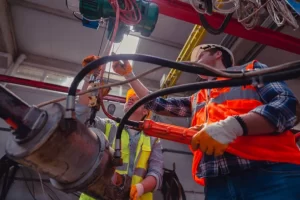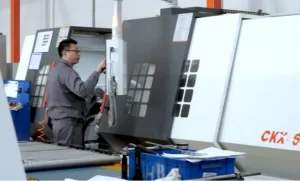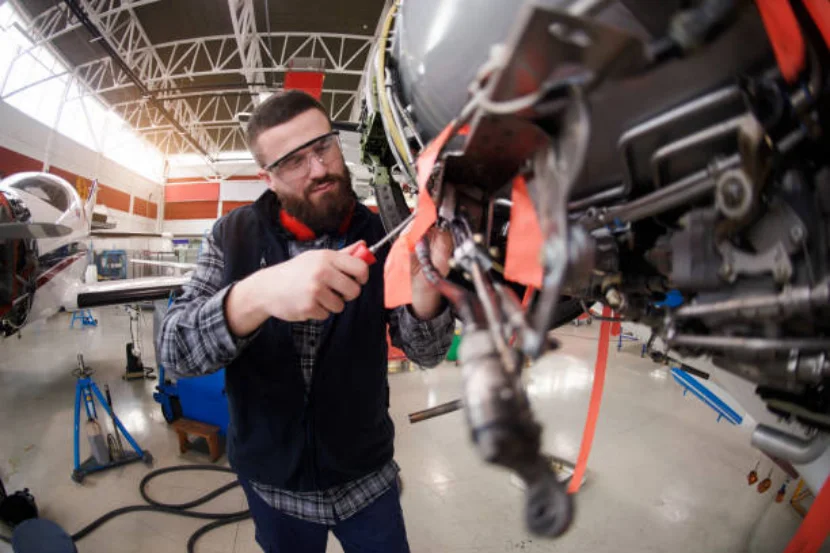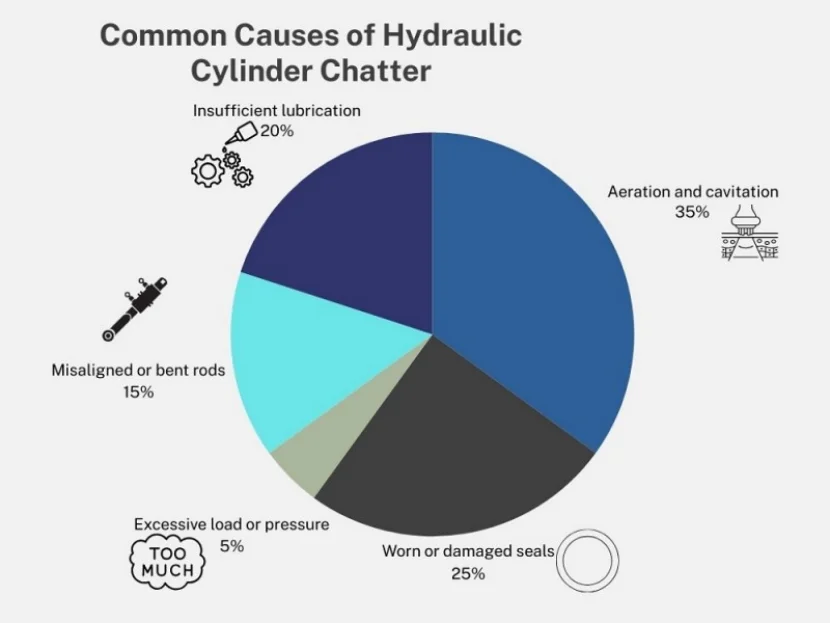Key Preparations Before Disassembling a Hydraulic Cylinder
Essential Tools for Disassembling Hydraulic Cylinders
To take apart a hydraulic cylinder, you need the right tools. These make the job smooth and safe. You’ll need wrenches, spanner sets, and seal kits. Special pullers are also helpful. A bench or floor vice is important too. It holds the cylinder steady. This prevents slips or accidents during hydraulic cylinder repair. Always check your tools. Make sure they’re in good shape. Broken tools can cause problems or damage the cylinder.
Safety Measures to Follow During Hydraulic Cylinder Repair
Safety comes first in hydraulic cylinder repair. Start by turning off the machine completely. Use lockout/tagout steps to stop it from starting by mistake. Wear safety gear like gloves and goggles. These protect against oil splashes or flying bits. Never work under heavy loads that might fall. Keep your workspace tidy. A clean area reduces risks of tripping or messing up the job.
Common Challenges in Disassembling Hydraulic Cylinders
Difficulty in Loosening Seized Components
A big problem in disassembling a hydraulic cylinder is stuck parts. Rust or long use can make bolts or nuts hard to turn. This blocks access to the cylinder’s insides. Penetrating oil can loosen these parts. Let it soak in for a bit. Heat can help too, but be careful. Too much heat might hurt seals or delicate pieces. Use heat only when needed and with caution.
Dealing with Damaged or Worn-Out Parts
Sometimes, you find broken seals, bent piston rods, or cracked nuts during hydraulic cylinder repair. These issues make disassembly tough. They also hurt how the system works. Replace worn parts quickly. Use high-quality replacement hydraulic cylinders or parts. Shining Hydraulic offers custom options that work well and keep systems running smoothly.
Managing Leakage During Disassembly
Leaks can happen when you disconnect hoses during hydraulic cylinder repair. To avoid mess, plug hoses right after you remove them. This stops dirt from getting inside. Clean the cylinder’s outside before you start. A clean surface lowers the chance of dirt sneaking into the system. This keeps your repair job safe and clean.
Effective Solutions for Hydraulic Cylinder Repair
Techniques for Loosening Stuck Components
To fix stuck parts in hydraulic cylinder repair, start with penetrating oil. Apply plenty and wait. This lets the oil seep into tight spots. For really stubborn parts, tap gently with a mallet. This can break rust loose without breaking anything. If that doesn’t work, use special pullers made for hydraulic systems. These tools remove tight parts safely.
Replacing Damaged Parts with Replacement Hydraulic Cylinders
If parts are too damaged, replace them. Choose strong replacement hydraulic cylinders that match your machine’s needs. Good parts keep the system working well. Shining Hydraulic provides reliable options. Their replacement hydraulic cylinders fit perfectly and last long. This ensures your system stays strong and dependable.
Proper Methods to Address Leakage Issues
Leaks often come from old seals or bad assembly in hydraulic cylinder repair. Check seals and O-rings closely. Look for wear or damage. Swap out any bad parts with high-quality ones that meet industry rules. During reassembly, add proper lubrication. This cuts friction and helps seals last longer. Good seals stop leaks and keep pressure steady.
Tips for Reassembling and Testing the Hydraulic Cylinder
Ensuring Correct Alignment of Parts During Reassembly
Putting a hydraulic cylinder back together needs care. Every part must line up right. Misaligned parts can cause problems or break the cylinder. Start by cleaning all pieces. Remove dirt or old oil from disassembling a hydraulic cylinder. Check seals and O-rings for wear. Replace them if they look bad. Lubrication is super important. It keeps parts moving smoothly and reduces wear.
Begin reassembly with the piston rod. Then add the piston nut and cylinder housing. Use the right tools to tighten parts. Don’t over-tighten, as this can harm threads or seals. Make sure the piston rod sits straight in the housing. This ensures the cylinder works well. Before hooking up hoses, move the piston by hand. Check for smooth motion. This confirms nothing is stuck.
Testing the Repaired Hydraulic Cylinder for Optimal Performance
After reassembling, test the hydraulic cylinder. This ensures it works right. Reconnect hoses tightly. Check for leaks at the connections. Slowly add hydraulic fluid. Watch pressure levels closely. Listen for odd sounds or look for leaks during hydraulic cylinder repair testing.
Try moving the piston rod in and out. See if it moves smoothly. Check if the speed and force are steady. If something feels off, like slow movement or weak force, there might be a problem. Take the cylinder apart again. Look for the issue, like a bad seal or wrong assembly. Fix it before using the cylinder in real work.
Choosing Quality Replacement Hydraulic Cylinders for Repairs
Factors to Consider When Selecting Replacement Parts
Picking good replacement hydraulic cylinders is key for hydraulic cylinder repair. First, make sure the parts fit your machine. Check size, pressure limits, and how they mount. Material matters too. Choose cylinders made from strong stuff like steel or aluminum. These last longer and handle tough jobs.
Reliability is a big deal. Pick replacement hydraulic cylinders from trusted makers. Shining Hydraulic makes parts with great care. They follow industry rules to ensure quality. Also, think about cost. Cheap parts might save money now but fail fast. This leads to more repairs. Good parts cost more upfront but save money over time.
Benefits of High-Quality Replacement Hydraulic Cylinders
High-quality replacement hydraulic cylinders bring lots of perks. They handle high pressure and heavy loads without losing accuracy. They move smoothly, which is great for jobs needing precision, like in construction or farming. These cylinders also save energy. They turn fluid power into work without wasting much. This cuts operating costs.
Top-grade materials make these cylinders last longer. They don’t wear out quickly. This means fewer repairs and less downtime. Good cylinders also improve safety. Reliable parts lower the chance of sudden breaks. This protects workers and equipment. Choosing replacement hydraulic cylinders from providers like Shining Hydraulic ensures great performance and a solid investment.
Frequently Asked Questions
How do I know if my hydraulic cylinder needs repair?
Look for signs like leaking oil, weak force, strange noises, bent piston rods, or damaged seals and housing.
Can I reuse old seals when repairing a hydraulic cylinder?
No, don’t reuse old seals. They might be worn or weak. Always use new seals made for your cylinder model.
What causes misalignment in hydraulic cylinders?
Misalignment can come from bad setup, worn bushings or bearings, or issues with connected machine parts.
How do I prevent contamination during reassembly?
Clean all parts well before reassembling. Keep your workspace free of dust. Plug hoses right after removal to block dirt.
Where can I find durable replacement hydraulic cylinders?
Shining Hydraulic offers strong, custom solutions for many industries. Their parts ensure great performance and last long.
Yantai Shining Hydraulic Technology CO.,LTD is based in Yantai Economic and Technological Development Zone—the Yantai Area of Shandong Free Trade Zone, China. They combine design, production, and sales to deliver quality solutions for customer needs.










